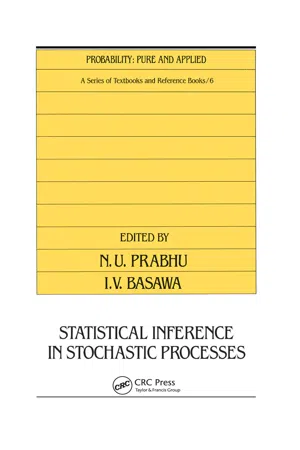
This is a test
- 288 pages
- English
- ePUB (mobile friendly)
- Available on iOS & Android
eBook - ePub
Statistical Inference in Stochastic Processes
Book details
Book preview
Table of contents
Citations
About This Book
Covering both theory and applications, this collection of eleven contributed papers surveys the role of probabilistic models and statistical techniques in image analysis and processing, develops likelihood methods for inference about parameters that determine the drift and the jump mechanism of a di
Frequently asked questions
At the moment all of our mobile-responsive ePub books are available to download via the app. Most of our PDFs are also available to download and we're working on making the final remaining ones downloadable now. Learn more here.
Both plans give you full access to the library and all of Perlego’s features. The only differences are the price and subscription period: With the annual plan you’ll save around 30% compared to 12 months on the monthly plan.
We are an online textbook subscription service, where you can get access to an entire online library for less than the price of a single book per month. With over 1 million books across 1000+ topics, we’ve got you covered! Learn more here.
Look out for the read-aloud symbol on your next book to see if you can listen to it. The read-aloud tool reads text aloud for you, highlighting the text as it is being read. You can pause it, speed it up and slow it down. Learn more here.
Yes, you can access Statistical Inference in Stochastic Processes by N.U. Prabhu in PDF and/or ePUB format, as well as other popular books in Mathematics & Mathematics General. We have over one million books available in our catalogue for you to explore.
Information
1
Statistical Models and Methods in Image Analysis: A Survey
The Johns Hopkins University, Baltimore, Maryland
This paper is a selective survey of the role of probabilistic models and statistical techniques in the burgeoning field of image analysis and processing. We introduce several areas of application that engender imaging problems; the principal imaging modalities; and key concepts and terminology. The role of stochastics in imaging is discussed generally, then illustrated by means of three specific examples: a Poisson process model of positron emission tomography, Markov random field image models and a Poisson process model of laser radar. We emphasize mathematical formulations and the role of imaging within the context of inference for stochastic processes.
Research supported in part by the National Science Foundation under grant MIP-8722463 and by the Army Research Office.
1 INTRODUCTION
Image analysis and processing is a field concerned with the modeling, computer manipulation and investigation, and display of two-dimensional pictorial data. Like many nascent fields, it is a combination of rigorous mathematics, sound engineering and black magic. Our objective in this paper is to present some key concepts and issues in image analysis, and to describe some probabilistic/statistical methods applicable to imaging problems. Our emphasis is on mathematical formulations and issues, rather than either theoretical details or empirical techniques.
In the broadest sense an image is a function f, whose two-dimensional domain, the image plane, is a (compact) subset of R2. The values of f represent brightness, and may be one-dimensional, in which case the image is called monochromatic and its values gray levels; or multidimensional, corresponding to brightnesses in several spectral bands, so that the image is colored. For simplicity we deal only with monochromatic images.
The ultimate objective of image analysis is generally – albeit not always – to display an image for viewing, examination and interpretation by humans. Thus, perceptual issues are important; for example, one must be careful not to confuse colored images with “false color” methods for display of monochromatic images. The latter map difficult-to-perceive gray levels onto colors, which are more easily distinguished by human viewers, for the purpose of displaying the image more informatively. We do not deal with perception here, though. The reader should be cautioned, moreover, not to adhere too dogmatically to the visual metaphor, since there are contexts, for example optical character recognition and robotics, in which it is not apparent that this is the best way to think.
In most realistic situations, images are realizations of random processes, leading to the following basic definitions.
Definition 1.1 (a) A continuous image is the realization of a random field {X(x,y):0 ≤ x,y ≤ 1}.
(b) A digital image is the realization of a discrete-valued random field {X(i,j) : 0 ≤ i, j ≤ n}. The X(i,j) are referred to as pixels (picture elements).
2 SOME GENERALITIES ABOUT IMAGING
Some key forms of imaging are:
CAT: computerized axial tomography
MRI: magnetic resonance imaging
PET: positron emission tomography
OCR: optical character recognition radar
ladar: laser radar
remote sensing (for example, from sa...
Table of contents
- Cover
- Half Title
- Series Page
- Title Page
- Copyright Page
- Preface
- Contributors
- Table of Contents
- 1 Statistical Models and Methods in Image Analysis: A Survey
- 2 Edge-Preserving Smoothing and the Assessment of Point Process Models for GATE Rainfall Fields
- 3 Likelihood Methods for Diffusions with Jumps
- 4 Efficient Estimating Equations for Nonparametric Filtered Models
- 5 Nonparametric Estimation of Trends in Linear Stochastic Systems
- 6 Weak Convergence of Two-Sided Stochastic Integrals, with an Application to Models for Left Truncated Survival Data
- 7 Asymptotic Theory of Weighted Maximum Likelihood Estimation for Growth Models
- 8 Markov Chain Models for Type-Token Relationships
- 9 A State-Space Approach to Transfer-Function Modeling
- 10 Shrinkage Estimation for a Dynamic Input-Output Linear Model
- 11 Maximum Probability Estimation for an Autoregressive Process
- Index